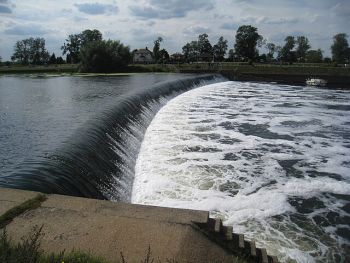Broad-Crested Weirs: Difference between revisions
From ASDSO Dam Safety Toolbox
(Created page with "__NOTOC__ Category:Spillway Control Structures ---- “These types of control structures are associated with staged releases and suited for auxiliary and emergency spillways. A fuseplug control structure may include one or multiple bays containing the fuseplug embankments. The zoned embankments will be placed to a specified height and include a pilot channel through each embankment crest set to a specified elevation associated with a given fl...") |
No edit summary |
||
| (2 intermediate revisions by one other user not shown) | |||
| Line 2: | Line 2: | ||
[[Category:Spillway Control Structures]] | [[Category:Spillway Control Structures]] | ||
---- | ---- | ||
{{Picture | |||
<!-- Add image file name (ex.image.jpg) --> | |||
|image= Cromwell_Weir.jpg | |||
<!--Add link if applicable --> | |||
|link= | |||
<!-- Add picture caption --> | |||
|caption= Cromwell Weir, Nottinghamshire. | |||
(Image Source: [https://commons.wikimedia.org/wiki/File:Cromwell_Weir_-_Nottinghamshire_(Geograph_2561867_by_Jonathan_Thacker).jpg Jonathan Thacker]) | |||
}} | |||
“A weir is a notch of regular form through which water flows. The structure containing the notch is also called a weir. The edge over which the water flows is the crest. The two basic types of [[weirs]] are [[Sharp-Crested Weirs|sharp-crested weirs]] and broad-crested weirs. Most hydraulic structures have broad-crested weirs. The crest is horizontal and long in the direction of flow so flow maintains contact with the crest rather than springing clear. The level crest in an earthen auxiliary spillway of a flood control dam is an example of a broad-crested weir."<ref name="NRCS650">[[National Engineering Handbook: Chapter 3 - Hydraulics|National Engineering Handbook, Part 650, Chapter 3 - Hydraulics, NRCS, 2021]]</ref> | |||
<!-- For information on notation for in text citations visit https://www.mediawiki.org/wiki/Help:Cite Or simply enclose the citation as shown <ref> citation </ref> in the location of the in text mention. Citations will automatically populate below--> | <!-- For information on notation for in text citations visit https://www.mediawiki.org/wiki/Help:Cite Or simply enclose the citation as shown <ref> citation </ref> in the location of the in text mention. Citations will automatically populate below--> | ||
Latest revision as of 14:53, 25 July 2023

|
| Cromwell Weir, Nottinghamshire.
(Image Source: Jonathan Thacker) |
“A weir is a notch of regular form through which water flows. The structure containing the notch is also called a weir. The edge over which the water flows is the crest. The two basic types of weirs are sharp-crested weirs and broad-crested weirs. Most hydraulic structures have broad-crested weirs. The crest is horizontal and long in the direction of flow so flow maintains contact with the crest rather than springing clear. The level crest in an earthen auxiliary spillway of a flood control dam is an example of a broad-crested weir."[1]
Citations:
Revision ID: 7442
Revision Date: 07/25/2023
